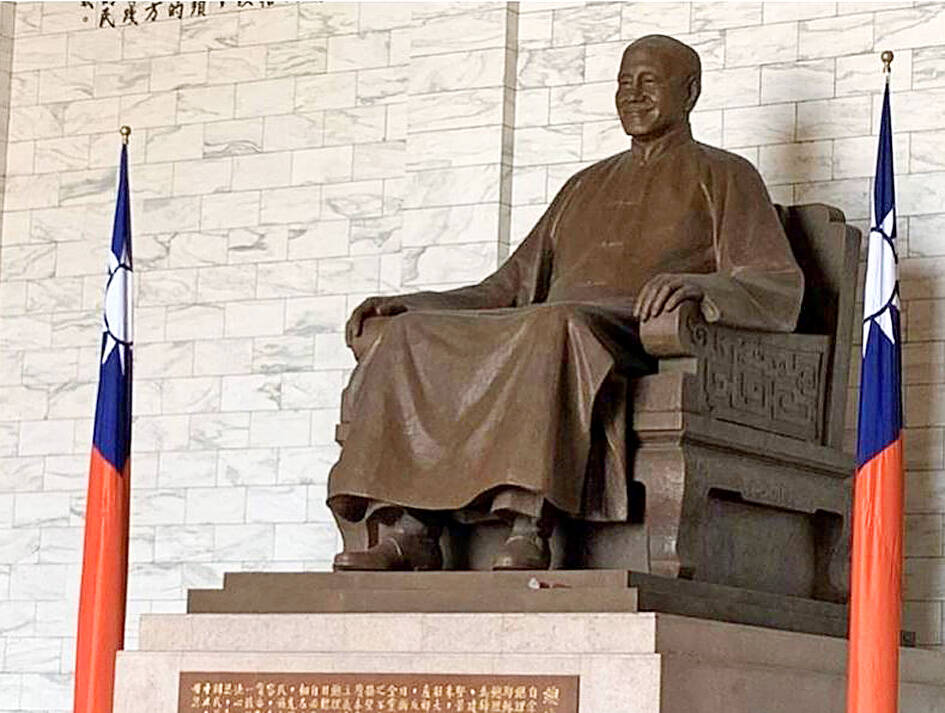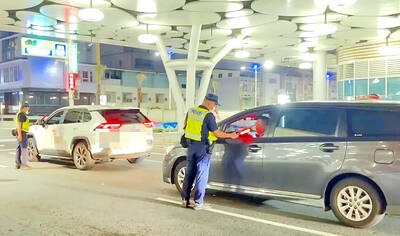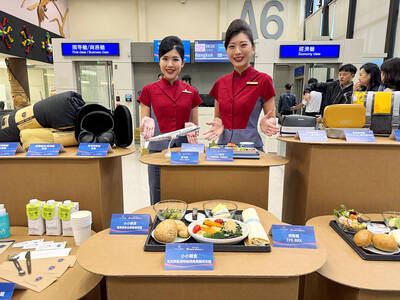Transitional justice is not possible while authoritarian-era symbols glorifying former presidents Chiang Kai-shek (蔣介石) and his son Chiang Ching-kuo (蔣經國) remain, many survivors and families of people persecuted in the 228 Incident said.
Today marked the 76th anniversary of the incident, a crackdown launched by the then-Chinese Nationalist Party (KMT) regime against civilian demonstrators following the killing of a bystander in a crowd in Taipei on Feb. 27, 1947.
Between 18,000 and 28,000 people were killed during the crackdown, which lasted into early May 1947, a government report released in 1992 showed.

Photo copied by Wang Kuan-jen, Taipei Times
It marked the beginning of the White Terror era in Taiwan, during which thousands of people were arrested, imprisoned or executed.
“Chiang Kai-shek was the prime culprit of the 228 Incident. He has massive amounts of blood on his hands,” Taiwan 228 Care Association chairman Wang Wen-hong (王文宏) said.
Despite Chiang Kai-shek’s record of brutality, a large statue of him stands in the chamber of the Chiang Kai-shek Memorial Hall, Wang said, which he described as “condescending.”
Then-governor-general Chen Yi (陳儀) on March 2, 1947, agreed to requests from local leaders to establish the 228 Incident Settlement Committee to investigate the Feb. 27 incident.
However, on March 6, hundreds of people heading to a meeting of the committee in Kaohsiung were fired upon, under the orders of the Kaohsiung garrison commander, major-general Peng Meng-chi (彭孟緝).
Wang’s father, Wang Ping-shui (王平水), was among those killed in Kaohsiung, historical records showed.
Wang Wen-hong was 32 days old at the time.
Over the next two decades, he grew up under an authoritarian KMT regime that did not teach children about the 228 Incident, and created an atmosphere of fear to keep people quiet about it.
In a high school essay about his father, Wang Wen-hong wrote that “my father was killed by bad guys in the 228 Incident,” which he learned from hearing relatives talk about it, without understanding what it was.
The essay terrified his mother, he said.
“She quickly threw a banquet for my teachers to apologize for my ‘innocence’ and bought a boat ticket to send me to Brazil,” he said. “She was worried the essay would get me into trouble if I were conscripted into the army.”
In Brazil, he learned that his brother, who was 14 years older than him, and their grandfather found their father’s body among a pile of corpses in a cattle trailer after a long search on the chilly, rainy evening of March 10.
He said they bribed KMT soldiers to bring the body home.
Wang Wen-hong returned to Taiwan after the term “transitional justice” was first codified into law in August 2016.
Wiping out the legacy of authoritarianism was also mandated by the Act for Promoting Transitional Justice (促進轉型正義條例), enacted in 2017.
Wang Wen-hong said that transitional justice would not be complete without dealing with the symbols of Taiwan’s authoritarian past, including the Chiang Kai-shek Memorial Hall and Cihu Mausoleum in Taoyuan’s Dasi District (大溪), where Chiang Kai-shek and Chiang Ching-kuo are interred.
Historical archives indicate that Chiang Kai-shek, who was in Nanjing, China, at the time of the 228 Massacre, ordered Chen to respond to the uprisings with a brutal crackdown, and sent troops from the mainland to quell the protests, said Kenneth Wang (王克雄), whose father, Wang Yu-lin (王育霖), was arrested on March 14 and later executed.
Those who opposed the removal of these symbols are unwilling to face history and admit to the mistakes made in the past, Kenneth Wang said.
He said he hopes that President Tsai Ing-wen (蔡英文) will keep her promises on transitional justice and that the KMT will have the courage to admit what it did so it can apologize with sincerity.
“Only by doing so can the historical trauma be healed and forgiveness and social reconciliation come about,” he said.
Eliminating the symbols could still be difficult. When the ad hoc Transitional Justice Commission was formed, there were about 966 statues of Chiang Kai-shek or Chiang Ching-kuo in public spaces and 580 places named after them nationwide, government data showed.
When the commission was dissolved in May last year, 80 percent of those symbols remained, the data showed.

TRAFFIC SAFETY RULES: A positive result in a drug test would result in a two-year license suspension for the driver and vehicle, and a fine of up to NT$180,000 The Ministry of Transportation and Communications is to authorize police to conduct roadside saliva tests by the end of the year to deter people from driving while under the influence of narcotics, it said yesterday. The ministry last month unveiled a draft of amended regulations governing traffic safety rules and penalties, which included provisions empowering police to conduct mandatory saliva tests on drivers. While currently rules authorize police to use oral fluid testing kits for signs of drug use, they do not establish penalties for noncompliance or operating procedures for officers to follow, the ministry said. The proposed changes to the regulations require

The Executive Yuan yesterday announced that registration for a one-time universal NT$10,000 cash handout to help people in Taiwan survive US tariffs and inflation would start on Nov. 5, with payouts available as early as Nov. 12. Who is eligible for the handout? Registered Taiwanese nationals are eligible, including those born in Taiwan before April 30 next year with a birth certificate. Non-registered nationals with residence permits, foreign permanent residents and foreign spouses of Taiwanese citizens with residence permits also qualify for the handouts. For people who meet the eligibility requirements, but passed away between yesterday and April 30 next year, surviving family members

China Airlines Ltd (CAL) yesterday morning joined SkyTeam’s Aviation Challenge for the fourth time, operating a demonstration flight for “net zero carbon emissions” from Taiwan Taoyuan International Airport to Bangkok. The flight used sustainable aviation fuel (SAF) at a ratio of up to 40 percent, the highest proportion CAL has achieved to date, the nation’s largest carrier said. Since April, SAF has become available to Taiwanese international carriers at Taipei International Airport (Songshan airport), Kaohsiung International Airport and Taoyuan airport. In previous challenges, CAL operated “net zero carbon emission flights” to Singapore and Japan. At a ceremony at Taoyuan airport, China Airlines chief sustainability

‘ONE CHINA’: A statement that Berlin decides its own China policy did not seem to sit well with Beijing, which offered only one meeting with the German official German Minister for Foreign Affairs Johann Wadephul’s trip to China has been canceled, a spokesperson for his ministry said yesterday, amid rising tensions between the two nations, including over Taiwan. Wadephul had planned to address Chinese curbs on rare earths during his visit, but his comments about Berlin deciding on the “design” of its “one China” policy ahead of the trip appear to have rankled China. Asked about Wadephul’s comments, Chinese Ministry of Foreign Affairs spokesman Guo Jiakun (郭嘉昆) said the “one China principle” has “no room for any self-definition.” In the interview published on Thursday, Wadephul said he would urge China to